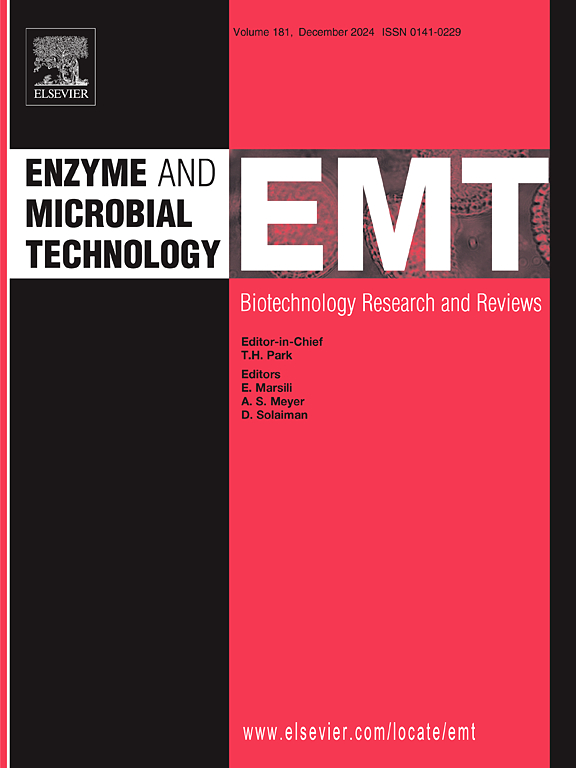Characterization of a GH10 family thermophilic, alkali- and salt-tolerant xylanase from Xinjiang salt lake
IF 3.7
3区 生物学
Q2 BIOTECHNOLOGY & APPLIED MICROBIOLOGY
引用次数: 0
Abstract
Xylanase is extensively employed in the food, feed, and paper sectors, with those derived from extreme environments offering distinct advantages. This study identified a novel xylanase gene (designated xynaes) through metagenomic analysis of samples from Aiting Lake, Xinjiang, China. Cloned and expressed in Escherichia coli after PCR amplification. The recombinant protein was purified using Ni-NTA affinity chromatography XynAES demonstrated optimal activity at pH 8.0 and 65 °C, its half-life (T1/2) was 120 min. XynAES preserved over 80 % residual activity after 12 h in pH 6.0–9.0 buffer. Its activity was enhanced to 132 % and 135 % in the presence of 1 mM Mg2+ and Zn2+, respectively. Additionally, XynAES maintained over 60 % relative activity in 0–3.0 M NaCl and its Km and Vmax of XynAES were determined to be 3.23 mg/mL and 72.46 μmol/min/mg, respectively. It is worth noting that the main products of XynAES enzymatic hydrolysis of xylan are xylose disaccharides and xylose tetrasaccharides, and XynAES shows obvious activity against the pre-treated wheat bran. In summary, XynAES is a thermophilic, alkali-tolerant, and salt-resistant xylanase, signifying its potential applications in the feed, food baking, paper manufacturing, and prebiotic production industries.
新疆盐湖GH10家族嗜热耐碱耐盐木聚糖酶的研究
木聚糖酶广泛应用于食品、饲料和造纸行业,在极端环境中产生的木聚糖酶具有明显的优势。本研究通过对新疆艾亭湖样品的宏基因组分析,鉴定出一个新的木聚糖酶基因(称为xynaes)。经PCR扩增克隆并在大肠杆菌中表达。重组蛋白经Ni-NTA亲和层析纯化得到,XynAES在pH 8.0和65℃条件下活性最佳,半衰期(T1/2)为120 min。在pH 6.0-9.0的缓冲液中,xnaes在12 h后保留了80% %的残留活性。在1 mM Mg2+和Zn2+存在下,其活性分别提高到132 %和135 %。在0 ~ 3.0 M NaCl中,XynAES的相对活性保持在60% %以上,其Km和Vmax分别为3.23 mg/mL和72.46 μmol/min/mg。值得注意的是,XynAES酶解木聚糖的主要产物是木糖二糖和木糖四糖,并且XynAES对预处理后的麦麸具有明显的活性。综上所述,XynAES是一种耐热、耐碱、耐盐的木聚糖酶,在饲料、食品烘焙、造纸和益生元生产等行业具有潜在的应用前景。
本文章由计算机程序翻译,如有差异,请以英文原文为准。
求助全文
约1分钟内获得全文
求助全文
来源期刊

Enzyme and Microbial Technology
生物-生物工程与应用微生物
CiteScore
7.60
自引率
5.90%
发文量
142
审稿时长
38 days
期刊介绍:
Enzyme and Microbial Technology is an international, peer-reviewed journal publishing original research and reviews, of biotechnological significance and novelty, on basic and applied aspects of the science and technology of processes involving the use of enzymes, micro-organisms, animal cells and plant cells.
We especially encourage submissions on:
Biocatalysis and the use of Directed Evolution in Synthetic Biology and Biotechnology
Biotechnological Production of New Bioactive Molecules, Biomaterials, Biopharmaceuticals, and Biofuels
New Imaging Techniques and Biosensors, especially as applicable to Healthcare and Systems Biology
New Biotechnological Approaches in Genomics, Proteomics and Metabolomics
Metabolic Engineering, Biomolecular Engineering and Nanobiotechnology
Manuscripts which report isolation, purification, immobilization or utilization of organisms or enzymes which are already well-described in the literature are not suitable for publication in EMT, unless their primary purpose is to report significant new findings or approaches which are of broad biotechnological importance. Similarly, manuscripts which report optimization studies on well-established processes are inappropriate. EMT does not accept papers dealing with mathematical modeling unless they report significant, new experimental data.
 求助内容:
求助内容: 应助结果提醒方式:
应助结果提醒方式:


